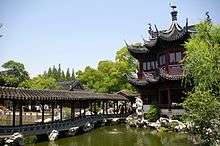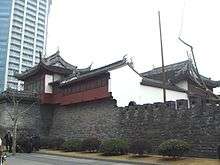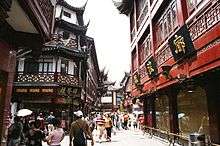Shanghai/Old City
The Old City is the area inside the ancient walled city of Shanghai; it is one of the most picturesque areas of the city, with many buildings in traditional Chinese style. Administratively the old city is part of Huangpu District, but it has its own distinct character and many tourist attractions so we treat it in a separate article.
Understand

The city began as a walled medieval town at least 1000 years ago. The walls, built mainly for protection against Japanese pirates, ringed the city around what are today Renmin and Zhonghua Roads. The walls have been demolished, but many locals still refer to localities by the names of the city gates - some of these have even become modern metro stops — Laoximen (old West gate) on lines 8 and 10 , and Xiaonanmen (little South gate) on line 9 .
During the era of foreign concessions (1842-1937), the International Settlement and the French Concession developed North and West of it, but the old city remained entirely Chinese and foreigners seldom ventured there; these days there are more foreigners since the area has become one of Shanghai's main tourist attractions. The "Old Town" is not exclusively old; tall modern buildings have started shooting up around the two main streets of the area, but you still have a chance to take in the atmosphere if you wander into the quaint side streets.
The center of the area is around the City God Temple and Yuyuan Garden. Apart from the temple and the garden itself, the neighborhood has a large pond well-stocked with enormous and quite photogenic goldfish, a pretty teahouse in the middle of the pond, many interesting old buildings, and extensive tourist-oriented shopping.
Get in

City God Temple is near the center of the Old Town, and is surrounded by the central commercial area. If you speak Chinese or have the name written down, telling any cab driver either "Cheng Huang Miao" (城隍庙, "City God Temple") or "Yu Yuan" (豫园, "Yuyuan Garden") will get you to the central commercial area around the temple, though the immediate surroundings are a pedestrian-only area. If you are going anywhere else in the Old City, asking for "Nan Shi" (南市, "Nanshi", the former district that covered the Old City) will get you to the vicinity.
The area is now well served by the metro. Line 10 Yuyuan Garden station, at the north end of the Old City, is not actually at the garden, but it is only a short walk and the area between is interesting, with several large markets selling knick-knacks and souvenirs. When it is completed in 2020, Line 14 will also come here.
Line 8 / 10 Laoximen (old West gate) station and line 8 Dashijie station are fairly close to the western part of the district (Dajing Tower). Line 9 Xiaonanmen (little South gate) station is close to Dongjiadu Cathedral. There are also numerous bus routes that serve the Old City.
From the southern part of the Bund, the City God Temple / Yuyuan Garden area is only a 10-minute signposted walk. You can also take a ferry from Dongcheng road (near the line 2 station) in Pudong to Jingling road south of the Bund and follow the above-mentioned signs. At Dongcheng Road Pier, the ferry departs from the right side - the other one goes to Fuxing Road which is less convenient.
Driving to this area is generally not a good idea since the streets are narrow and parking quite hard to find. There is a parking area quite close to the center, but it is only for tour buses.
See
- 🌍 City God Temple (城隍廟 Chénghuángmiào, Old City God Temple), 249 Fangbang Zhong Lu (Metro line 10 Yuyuan Garden). A well-known Taoist temple at the centre of the Old City, one of the biggest examples of traditional Chinese architecture in Shanghai. You can find local snacks and food as well as other traditional Chinese decorations in the surrounding commercial area.

- 🌍 Old City Wall (Dajing Ge Pavilion), 269 Dajingge Lu 269 (Metro line 8 Dashijie or 10 Yuyuan Garden), ☎ +862163266171. 9AM-4PM. The small surviving part of the Shanghai city wall. A prominent feature is Dajing Tower. If you want to see a larger and better preserved wall, go to nearby Suzhou, or Nanjing.
- 🌍 Jiu Qu Qiao Bridge. A zig-zagging bridge near the City God Temple, the present construction dates from the early 20th century.
- 🌍 Dongjiadu Cathedral (St. Francis Xavier) (Metro line 9 , Xiaonanmen Station). Saturday 9-15, Sunday 10-16. Built by Spanish Jesuits in the 19th century, the historic seat of the Bishop of Shanghai. A relatively small church near the river, outside the old city wall. In 2018 the church is surrounded by a huge construction site and it's closed.
- 🌍 Yu Garden (豫园 Yù Yuán "Garden of Contentment"), 29 Chenxiangge Lu (Metro line 10 Yuyuan Garden), ☎ +86 21-63282465. 8:30am-5:30pm. A traditional Chinese Ming-style private garden, originally built in 1559 but ransacked and restored several times since then. Entrance price is worth it for the many exquisite Chinese pavilions, seemingly never-ending paths, and sculpted gardens within. Near the garden, the famous zigzag bridge and its teahouse (see Drink) can be visited. The bazaar near the garden is always crowded with tourists. ¥40.
- 🌍 Chenxiang Ge Temple, 338 Fuyou Road. A historic Buddhist temple, with a statue on the upper floor carved from a rare wood.
- 🌍 Baiyun Guan Temple (White Cloud Temple), 239 Dajing Road. 8AM-4PM. A Taoist temple. Look for the statue of the guardian spirit for your Chinese zodiac.
- 🌍 Xiaotayuan Mosque, Xiaotaoyuan Jie 52. A historic mosque that combines Chinese and Islamic architectural styles. Shanghai's largest mosque, with a separate women's mosque next door.
- 🌍 Wenmiao Temple, Wenmiao Lu 215 (Metro line 8 / 10 Laoximen). The Temple to Confucius, with Shanghai's most famous vintage book market.
Do

- City God Temple (Lao Cheng Huang Miao). The area around the Old City God Temple and the Yuyuan Gardens has become a large commercial hub, with many restored historical buildings as well as new buildings in a somewhat traditional style. Take photos, shop for souvenirs, and enjoy the many restaurants and eateries. Enjoy an illuminated diorama or other forms of 19th century street side entertainment. Come after 6:30PM when the lights show off the beauty of the buildings in a new way. Eat upstairs at one of the restaurants overlooking the square on Yu Yuan Lu (with a pond criss-crossed by a zigzag bridge and tea room) and see the reflections of the lights. (The City God Temple lies at the southern end of this commercial area, and the Yuyuan Garden at the northern end: the entrance to the Garden is near the zigzag bridge).
Buy
There are a range of shops here, from quite large places on some of the main streets to groups of smaller shops along the alleys. The specialties are souvenirs and tourist trinkets, arts and crafts, and clothing. There are also a few large shops for upmarket jewellery.
If you plan to shop for antiques or Mao-era kitsch, the best route may be to take metro line 8 or 10 to Laoximen, walk a bit North to the Dongtai Road market (see Shanghai#Antiques), then head East into the Old City. The two bits of walking — metro stop to antique market then from there to Yuyuan Garden — are both fairly short; total distance is under 400m (a quarter mile).
- Fuyou Antique Market. One of several multi-storey markets near Yuyuan metro station, at the northern end of the Old City - shop here for souvenirs, craft both modern and antique, as well as clothes and toys.
- Shiliupu Fabric Market (Next to an Old Town market where you will see badgers, bear claws and interspecies intimacies). A warren of tailor shops offering custom made clothes, from tuxedoes to dress shirts to fake designer jackets and qipao, the traditional Chinese dress with a slit up the thigh. The prices are cheap but expect a lot tinkering afterward as your tailor will not be able to remake something as you like unless you tell her exactly what you want. The tailoring itself is average. Bargain hard and be familiar with the prices it would cost at a major retailer. Be ware that this is the place to buy cheap tailor-made clothing, it will not necessarily be cheap compared to mass-produced, chain store wares - even after bargaining, just getting a mass-produced shirt from an H&M will be about the same price, but the H&M shirt will likely be much better quality.
See Shanghai#Antiques and Shanghai#Clothing for other places to shop for similar goods.
Eat
There are also a range of restaurants, including a few well known historic restaurants specializing in Shanghainese cuisine. The Old City is however best known for its diverse offering of snack foods or dianxin - tour the old city like a local, picking up snacks from stalls and stopping at bun restaurants and tea houses along the way.
For a historic Chinese area, Western fast-food chains are also surprisingly well represented; there is a very busy Starbucks right opposite the teahouse in the pond, a large KFC on the second floor above one of the larger shops, and various side streets have a Dairy Queen, another Starbucks and a couple of McDonalds.
- Nanxiang Steamed Bun Restaurant (Nanxiang Mantou Dian) (Near the zigzag bridge opposite the tea house). Founded in 1900, this is the best-known restaurant specializing in small soup-filled buns called Xiaolongbao (also commonly referred to as "soup dumplings"), a characteristic Shanghai snack. This restaurant is popular for take-away and sit-down. The sit-down section (up the stairs) has a range of options - from the cheapest first floor dining room where you sit elbow-to-elbow with other patrons, to the "VIP section" with a large minimum spend. As a guide, the higher you go, the more expensive the offerings: for example, the first floor dining room serves pork and crab meat buns and simple shredded egg soup, whereas the third floor dining room serves crab roe and soft roe buns and egg and scallop soup. The line for take-away is quite long and takes 90 min or more before soaking your teeth in some of the best (and cheapest) ones in Shanghai. Be careful not to scald your mouth with the hot liquid. (Closed March to September 2018 for renovations, during which time the restaurant will temporarily operate from 5 Bailing Road, nearby) ¥20-¥60.
- Ningbo Dumpling Shop (Ningbo Tangyuan Dian). Another historic restaurant specializing in Ningbo-style Tangyuan ("rice dough balls" or, confusingly, also "soup dumplings"), another popular snack. This restaurant offers Tangyuan with fillings found almost nowhere else, both sweet and savoury. A separate counter offers a range of Shanghainese small dishes. ¥20.
Drink
- Mid-Lake Pavilion Teahouse (湖心亭 Húxīntíng). In the Yuyuan Gardens and reached by a 9-legged zigzag path to stop evil spirits. One of the most famous tea houses in all of China. A glass (not a pot) of your tea of choice is ¥20-25 downstairs and ¥40-55 upstairs — upstairs you'll get nice views, respite from the crowds, free snacks and even a souvenir or two. Pressure-free.
Sleep
The old town has few hotels, but Huangpu District and the eastern part of the French Concession are both within easy walking distance and both well-provided with hotels. One might also go further afield to more suburban areas with a better choice of moderately-priced accommodation and food; the Hongmei Lu area in Minhang or the area around Tongji University in Yangpu are both readily accessible from the old town via metro line 10 .